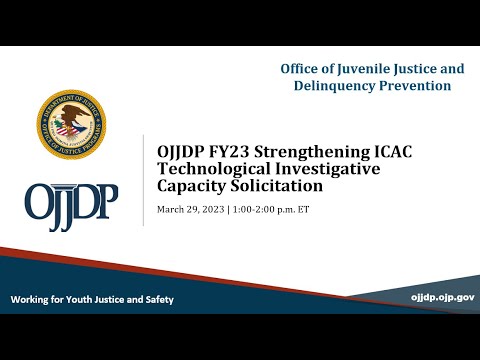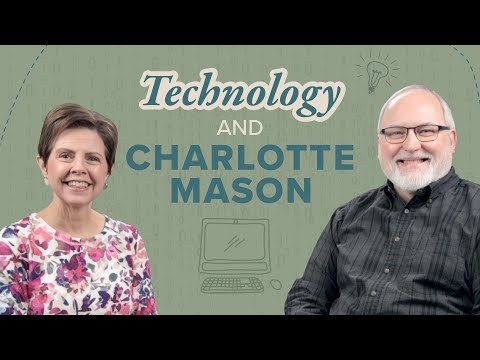OJJDP FY 2023 Strengthening ICAC Technological Investigative Capacity (Webinar)

Eileen LeFurgy: Hello everyone and welcome. Thank you for joining us today. This grant webinar is for strengthening ICAC technological investigative capacity. I have my colleague Callie Murray with me. I'm Eileen LeFurgy from OJJDP's NTTAC. Just so you know, this webinar is being recorded and it will be published on OJJDP's multimedia page.
Some tips available: we have live captioning. If you click on the multimedia viewer, you can view the live captioning there. If you're having issues with audio, you can have the “Call Me” feature enabled and it can call you back to have better audio. If you have any technical problems during the event, you can feel free to send me a private chat message.
You can also message Callie. If you have any questions during the webinar, you can send a chat message to all panelists and we will receive your questions and answer them at the Q&A session. If any of you are attending as a group, please put in the chat how many people you have with you so we can get an accurate representation of how many people attended. And I'm now also joined by Trevor Wulff, my colleague at NTTAC, so he can help if you have any issues during the presentation. So with all of that said, I'm going to introduce the moderator Alex Sarrano. Alex Sarrano: All right.
And I believe I have control now, correct? Eileen LeFurgy: Yes. Alex Sarrano: All right. Let's see. There we go. All right. Well, welcome.
My name is Alex Sarrano and I'll be the moderator for today's webinar on the FY 2023 Strengthening ICAC Technological Investigative Solicitation. I work in the Office of Juvenile Justice and Delinquency Prevention, also known as OJJDP. It looks like we skipped a couple slides.
That's okay. So let me start by giving a bit of background about my office. As you can see ‑‑ well, see here.
All right. So at OJJDP, we envision a nation where our children are free from crime and violence and if they do happen to come into contact with the justice system, we want that contact to be both just and beneficial to them. By supporting states, local communities, and travel jurisdictions in their efforts to develop and implement effective programs for juveniles, our office strives to develop effective and equitable juvenile justice systems that create safer communities and empower youth to lead productive lives. So today I'll be discussing the FY 23 strengthening ICAC technological investigative capacity solicitation-- we call it ICAC tools. And we'll do the following: So I'll be providing a general overview of the grant application process.
I'll highlight key eligibility and solicitation requirements. Identify tools and resources for applicants that will help facilitate the application process. And provide an opportunity for applicants to ask questions.
So overall, I'll be providing a general overview of the solicitation and I hope this overview is useful to you as you develop your application. All right. So on this slide, you can find a link to the solicitation along with the key deadlines.
Please note that there are two separate application deadlines and you can find more details on what you need to submit for each deadline on page 3 of the solicitation. To summarize, the first is for grants.gov with a deadline of April 26th by 11:59 p.m. eastern standard time.
For this one, you'll need to submit the required application for federal assistance- Standard Form. That's also known as SF‑424. As well as the Disclosure of Lobbying Activities Form, which is also known as SF‑LLL. So, the second deadline is for JustGrants with a deadline of May 10th by 8:59 p.m. eastern standard time. This is located entirely in JustGrants and it's there that you'll submit the full application package, including all associated attachments.
And now I'll go ahead and start with a general overview of OJJDP's grant application process. So on this slide, you'll find a list of type of applicants that may submit an application. I won't read the whole list, but they include state governments, city or township governments, county governments, among others. So basically, anything you see on this page.
On this slide is a list of the elements that must be included in the application. I'll talk about the first five items later, but I'll go over the last two items now. The Indirect Cost Rate Agreement must be included as a separate attachment if you're planning on claiming any indirect costs in your budget. The Financial Management System of Internal Controls Questionnaire helps OJJDP assess an applicant's financial management and internal control system. Make sure it's basically up to snuff. It's generally advised that you have the applicant's staff fill out this questionnaire and you can find that on the Indirect Cost Rate Agreement and the questionnaire on pages 20 and 21 of the solicitation.
So, there are also several other documents that you must include with your application. Research and Evaluation Independence and Integrity Form is something you need to fill out as part of your project. It allows OJJDP to assess that the applicant demonstrates independence and integrity regarding the research and/or evaluation. The request and justification for employee compensation is something you would provide in your budget narrative if you're proposing to pay them at a rate that exceeds 110% of the annual maximum salary payable to the Federal Government's senior executive service level- SES. So, this is essentially a waiver request where you would identify whom this applies and why you believe paying them this much is necessary for your award.
This also includes copies of resumes for all key personnel funded under the project and provide job descriptions outlining the roles and responsibilities for all key positions. If you're proposing to implement a project where you do a lot of coalition-building work with pilot sites or work with other partners in general, you must provide Letters of Support or Memoranda of Understanding from these partner organizations so as to clearly demonstrate these partners are actually on board and will assist you with your project. If you're a tribe, tribal organization, or third party that proposes to provide direct services or assistance to residents on tribal lands, then you should include a resolution letter or some other sort of documentation that demonstrates that you have the required authorization from the tribe or tribes to implement the proposed project on tribal lands. The organizational chart is something you should submit to clearly show how the organization operates, including who manages the finances, how the organization manages sub-awards, if you have any, and the management of the project.
And if you have any, you'll also need to provide a list of all procurement contracts you'll be paying through the award if they're known at the time of your application submission. Lastly, there are a few disclosures and assurances you'll need to fill out, including the Disclosure of Lobbying Activities, which I mentioned earlier. And that's completed in grants.gov as part of initiating your application submission
and that tells us if you plan on using any award funds for lobbying activities. The Certified Standard Assurances are something that you would review and accept in JustGrants. The Applicant Disclosure of Duplication and Cost Items, which tells us whether you have any other pending applications for federally‑funded awards, include requests for funding to support the same project that you propose in this application. If you do, this form would specify any budget items that were requested through those separate applications that are identical to the one in this application. The DOJ High‑Risk Grantee Disclosure Form must be submitted if the organization currently has a DOJ high‑risk designation based on internal control deficiencies and other things. And finally, lobbying, debarment, suspension, and other responsibility matters and drug-free workplace requirements.
You review and accept those certifications in JustGrants. You can find the full list and any association- most of what I just said on pages 22 to 23 of the solicitation. They must be included in the application submission to meet the BMR to advance to peer review and receive consideration for funding. You have to include the proposal abstract, the proposal narrative, and the budget worksheet and budget narrative. So, I mentioned the SF‑424 earlier.
It's the required standard form used as a cover sheet for submission of pre‑applications, applications, and related information. This is something you would fill out as part of your grants.gov submission and you can see more about how to submit them exactly on page 16 of the solicitation announcement. The Standard Applicant Information section is prepopulated with the SF‑424 data submitted in grants.gov. Applicants will need to review the standard applicant information in JustGrants and make edits as needed.
Within this section, applicants will need to add zip codes for areas affected by the project, confirm their authorized representative, and verify the organization's legal name and address. A proposal abstract needs to be included as well. This is a document of no more than 400 words in length that summarizes your proposed project. You would briefly cover the purpose of the project, your primary activities, expected outcomes, service area, and intended beneficiaries. This is a completed ‑‑ this is completed through a JustGrants web-based form and should be written in the third person. This should go without saying, but please ensure that it is well written because if you are awarded the project, your abstract will be made publicly available on the OJP website.
The document should be double-spaced, using 12-point font, have no less than one‑inch margins, and should not exceed 30 pages. You should also number your pages -- makes it easier for the reviewers. If the proposal narrative fails to comply with the length restrictions, we may take this into consideration when making the final award decision, so please do not go over 30 pages. So, a key part of your narrative will be addressing the goals, objectives, and deliverables of your project and ensuring they align with the needs of this program.
The goal of this program is to increase the technological investigative capacity and associated training of law enforcement, prosecutors, and other professionals nationwide to combat child sexual abuse material, otherwise known as CSAM, and online child sexual exploitation, including cases of child sex trafficking. So, this program is split into three separate categories, each consisting ‑‑ or each covering a separate objective. Category 1 aims to support the development of widely used investigative tools, methods, and technologies that address CSAM and online child sexual exploitation, including cases of child sex trafficking. Category 2 aims to support the enhancement or refinement of widely used investigative tools, methods, and technologies for the same purpose.
And Category 3 aims to increase the amount and availability of new and/or advanced skill-based training for the law enforcement community and prosecutorial agencies nationwide on widely used tools, methods, and technologies for the same purpose. So please note that only one category may be addressed per application. You can have multiple applications, but they each have to address a certain category. So regardless of which category is chosen, there are a few deliverables that must be submitted. You must have a timeline or work plan for the development, refinement, and advancement of the proposed investigative tools, methods, technologies, or training depending on whichever category you choose. A plan for how the proposed product or training will be marketed and made available to law enforcement, prosecutors, and other professionals on a nationwide -- I'll stress that one -- nationwide basis.
And sustainability plan for the proposed product. In other words, after OJJDP funding runs out, how will you continue the project? And let me just go back to that nationwide word, because there has been some confusion in the past. So, the proposed product or training can't be made available and useful only to a particular county, state, or even region. It needs to be available and beneficial on a nationwide level. So please keep that in mind when you're thinking about what you want to do for your project. So in the description of the issue portion of the narrative, applicants should briefly describe the scope of technology‑facilitated crimes against children across the country, the need to investigate these crimes, and the need for support, training, and tools to increase law enforcement and prosecutorial capacity to investigate and prosecute internet crimes against children.
The applicant should use data to provide evidence that the problem exists, demonstrate the size and scope of the problem, and document the effects of the problem on the target population and the larger community. They should demonstrate that they have consulted with criminal justice agencies to gain a fuller understanding of these challenges and the operational context within which these tools or training would be employed and they must describe and cite all reference research or evaluation studies. Show your work.
In the project design implementation portion of the narrative, applicants should detail how the project will operate throughout the funding period and describe the strategies that they will use to achieve the goals and objectives identified in the solicitation. In order to do that, you should outline and describe the proposed investigative tools, methods, or technologies and/or describe the proposed training for the law enforcement community and prosecutorial agencies nationwide on tools, methods, and technologies. You should identify the gaps or planned improvements in the described tools and technologies. You should demonstrate how they are consulted or how you have consulted with criminal justice agencies to understand current challenges and how the tools or training would be employed to meet those challenges. And lastly, you should indicate how the proposed product will target emerging technologies, offender organizations, high‑value individual offenders, better identify victims, or enhance international collaboration.
So in this section, applicants should include details regarding any leveraged resources - cash or in kind - from local sources to support the project and discuss plans for sustainability beyond the grant period. It's here that you would also submit a realistic timeline milestone chart as a separate JustGrants attachment that indicates major tasks and goals of the project. Let me actually just go back - make sure you understand.
So basically, the timeline or milestone chart -- it will be part of the selection criteria under the project design implementation section. However, it should be submitted as a separate attachment. It wouldn't be in the narrative so much -- it would just be included as a separate attachment. And you can ‑‑ in your actual narrative itself -- you can refer to the attachment X, Y, or Z or whatever and just refer to that -- you have a timeline somewhere in your application package.
All right. In the Capabilities and Competency section of your narrative, applicants should describe the experience and capability of the organization. Any contractors or ‑‑ and any contractors or subgrantees that you'll use for the project, highlighting any previous experience involving projects of similar design or magnitude. You should also highlight your experience, capability, capacity, and overall success in the development and/or delivery of training for law enforcement and prosecutorial agencies nationally.
Including details on your system for fiscal accountability. And this is where you would also include a copy of an organizational chart showing how the organization operates, including who manages the finances, how you manage sub-awards, if there are any, and as well as how the management of the proposed project would work. Management and staffing patterns should be clearly connected to the project design described in the Project Design and Implementation section.
So, there should be a connection there. The final section of the narrative covers the applicant's plan for collecting the data required for performance measures. Here, you would describe the process for measuring project performance, and you would do this by identifying who will collect the data, identify who is responsible for performance measures, describe how the information will be used to guide and evaluate the impact of the project, and describe the process that will be used to accurately report data.
And I'll note that you're not required to submit performance data with the application. All right. The Budget Worksheet and Narrative portion of your application will be completed through the JustGrants web‑based budget form. So, the budget form should thoroughly and clearly describe every proposed expenditure. OJP expects the proposed budget to be complete, cost‑effective, and allowable. So, the Department of Justice is committed to advancing work that promotes civil rights and racial equity, increases access to justice, supports crime victims and individuals impacted by the justice system, strengthens community safety and protects the public from crime and evolving threats, and builds trust between law enforcement and the community.
Consequently, there are a few priority areas associated with this solicitation. By addressing the first priority area called 1‑A, OJP will give priority consideration to applications that include projects ‑‑ which include a project which promotes racial equity and the removal of barriers to access an opportunity for communities that have been historically underserved, marginalized, and adversely affected by inequality when making award decisions. You must ‑‑ if you decide to go for this priority area, you must describe how the proposed project will address potential inequities and barriers to equal opportunity and/or contribute to greater access to services to underserved and historically marginalized populations.
If you do decide to do this priority, you should address it in the project ‑‑ under the Project Design and Implementation section of the narrative. By addressing the second priority area called 1‑B, OJP will give priority consideration to applicants that can demonstrate that their capabilities and competencies for implementing the proposed project are enhanced because the applicant identifies as a culturally specific organization. In order to receive this additional priority consideration, you must describe how being a culturally specific organization or funding the culturally specific sub-recipient organization if you have one will enhance their ability to ‑‑ will enhance your ability to implement the proposed project and you should also specify which culturally specific populations are intended or expected to be served or have their needs addressed under the proposed project. If you're looking to do this one, you should address it in the Capabilities and Competencies section of the narrative. All right.
Moving on to the selection process. So, if you meet the basic minimum requirements, you'll be evaluated by peer reviewers using the following review criteria: the statement of the problem section will be worth 10%; the project design and implementation will be worth 45%; capabilities and competencies - 30%; plan for collecting the data required for this solicitation's performance measures - 10%; and budget is worth 5%. So during the application review process, OJJDP reviews the application to make sure that the information presented is reasonable, understandable, measurable, and achievable, as well as consistent with the solicitation. Peer reviewers will review the applications submitted under the solicitation that meet basic minimum requirements and other important considerations for us including geographic diversity, strategic priorities, and available funding. And lastly, pursuant to the Part 200 Uniform Requirements, before award decisions are made, OJP also reviews information related to the degree of risk posed by your organization, among other things, to help assess whether an applicant has had one or more prior federal awards that had a satisfactory record with respective performance, integrity, and business ethics. OJP also checks whether the April scant listed in SAM.gov is excluded from receiving a federal
award. So as was mentioned earlier, there are two deadlines to meet when submitting your application: the grants.gov deadline -- April 26th by 11:59 eastern standard time -- and the JustGrants deadline, which is May 10th, 8:59 p.m. eastern standard time. You'll submit an SF‑424 and an SF‑LLL in grants.gov and the full application will be submitted in JustGrants, including attachments.
I would advise you to register with grants.gov as soon as possible as the application process can take a little bit of time. OJP also urges applicants to submit applications at least 72 hours prior to the application due date to allow time to receive validation messages or rejection notifications from grants.gov,
SAM.gov, or JustGrants And to correct, in a timely fashion, any problems that you may have caused in order for rejection notification to show up. So don't wait until the zero hour. I've seen time and time again where an applicant will wait two hours before something is due and two -- oh, wait, I can't submit it for whatever reason.
It's, well, too late. So don't wait until zero hour. Allow yourself some time -- give yourself at least 72 hours. So OJJDP strongly encourages all prospective applicants to sign up for grants.gov email notifications regarding the solicitation. If the solicitation is modified, individuals who sign up for this with grants.gov for updates
will automatically be notified. Late applications are not accepted unless there's a problem with grants.gov, SAM.gov, or JustGrants on our end.
A problem on the applicant's side will not result in a waiver to submit late. All right. Here's the contact information for grants.gov.
If you need any technical assistance with submitting your SF‑424 or SF‑LLL, please give them a call or email. Here's the contact information for JustGrants. If you need any technical assistance with submitting your actual application and attachments, here's their contact information. And here are some links to some grant writing tips to assist you as you write up your application. And that is all from me. Alex Sarrano: I know we received some questions that you submitted before the webinar and all of them should have been addressed as I worked my way through these slides.
Otherwise, if you still have some questions or if you have any other questions, I'm happy to answer them right now. Eileen LeFurgy: Okay. Well, if there are no questions, I'm going to go ahead and wrap up here.
We just have a few slides ‑‑ this PDF will be emailed to all attendees after the presentation is over, so you'll have access to all these links. We have a link to JustGrants and NTTAC. You can email us at this email if you have any questions about the webinar. And if you have a training or technical assistance need, you can submit a request via our TTA360 system and here are links to OJJDP and the JUVJUST listserv and to see all upcoming events.
And as I mentioned, this will be recorded and listed on the multimedia page and the YouTube channel. You can view more on juvenile justice and child victimization prevention-related topics at these links. Disclaimer: we make every attempt to ensure the material presented during this webinar is accurate. In the case of errors, the written solicitations will take precedence. And here are more ways to connect with OJJDP and with that, we are going to conclude if there are no further questions. Okay, well then thank you everyone for joining us today.
2023-04-13 03:49


